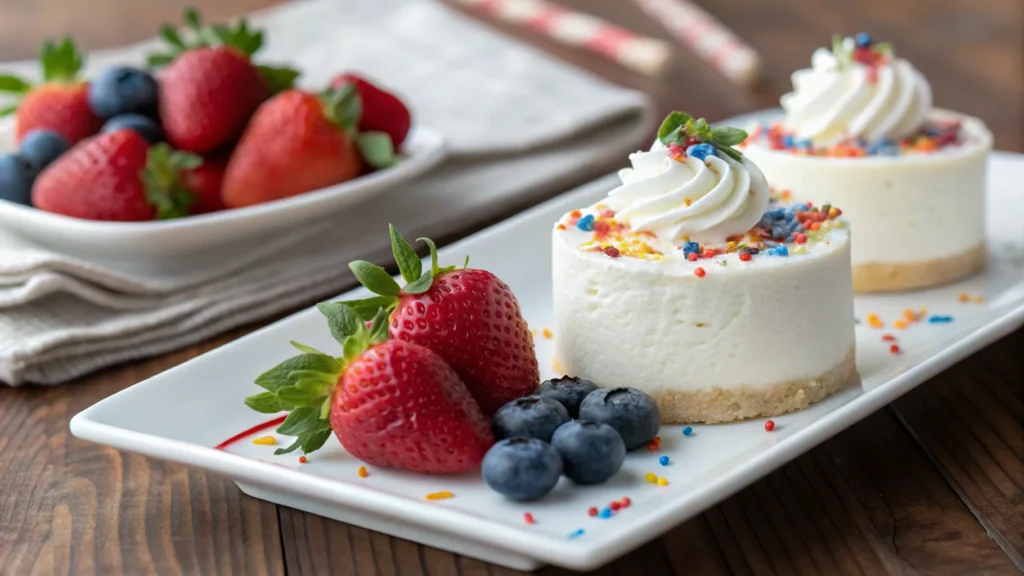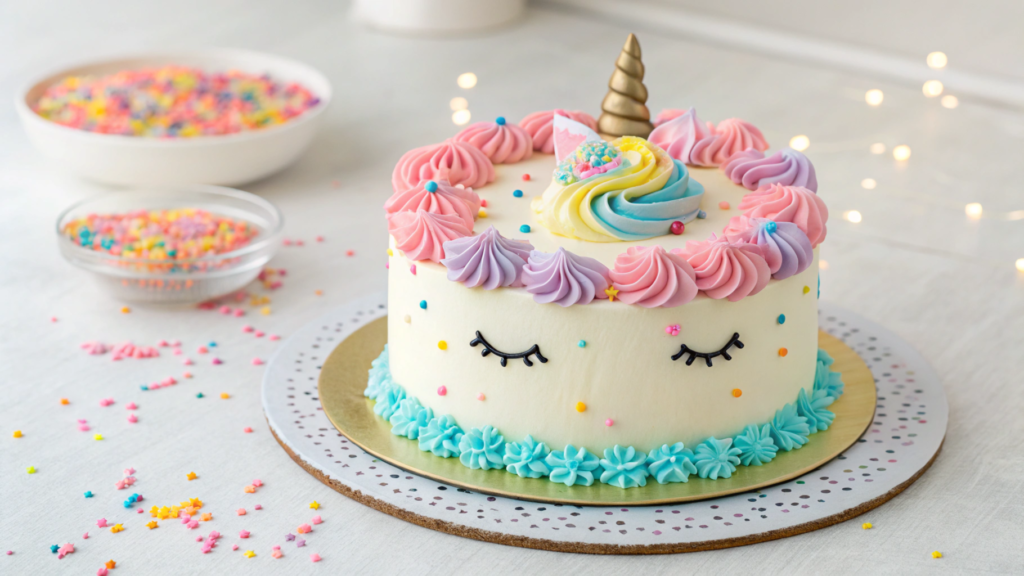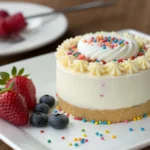Mini cakes are a delightful trend that’s here to stay, combining charm and indulgence in bite-sized portions. Whether you’re hosting a party, looking for a quick treat, or experimenting with baking, these tiny desserts bring versatility and creativity to the table. In this guide, we’ll explore everything from the types of mini cakes to baking tips and where to find the best ones. Let’s dive into the enchanting world of mini cakes.
What Are Mini Cakes?
Defining Mini Cakes: From Cupcakes to Layered Delights
Mini cakes, as the name suggests, are small-scale versions of traditional cakes. They can be as simple as a single-serving layered sponge or as intricate as a fondant-covered masterpiece. These bite-sized creations differ from cupcakes by offering the full cake experience frosting, filling, and all in a smaller package. Their compact size makes them perfect for those seeking indulgence without overindulgence.
These little desserts come in all shapes and forms, from classic circular designs to heart-shaped or square delights. The versatility of mini cakes allows bakers to experiment with flavors, decorations, and styles that suit any occasion, from casual get-togethers to elegant celebrations.
Why Mini Cakes Are Gaining Popularity
The rise of mini cakes can be attributed to the growing demand for personalized and portion-controlled desserts. In an era where people crave variety, these cakes offer just the right amount of sweetness without overwhelming the palate. They’re ideal for sampling different flavors, making them a hit at parties, weddings, and corporate events.
Additionally, mini cakes cater to modern trends like eco-consciousness and dietary awareness. Their smaller size often reduces waste, and many bakeries now offer vegan, gluten-free, or low-sugar options, ensuring there’s something for everyone. With their photogenic appeal and customizable nature, mini cakes have become the centerpiece of Instagram-worthy dessert tables.
Types of Mini Cakes
Single-Serve Layered Cakes
A single-serve layered mini cake is a miniature version of a classic layered cake, complete with multiple tiers of sponge, fillings, and frosting. These cakes provide a sophisticated dessert experience in a perfectly portioned size. Whether it’s a vanilla sponge layered with buttercream or a decadent chocolate cake with ganache, their appeal lies in their ability to replicate the full cake experience in a bite-sized treat.
Perfect for individual servings, these cakes often steal the show at weddings and upscale events. They’re easy to personalize with unique decorations, making them a crowd-pleaser for any occasion.
Mini Cupcakes and Muffins
When people think of mini cakes, they often picture mini cupcakes—smaller, handheld versions of their larger counterparts. Unlike traditional cakes, cupcakes are designed to be eaten without utensils, making them perfect for casual events or on-the-go snacking.
Muffins, while less sweet and often categorized as breakfast treats, can also double as mini desserts when topped with frosting or a drizzle of glaze. Both options are versatile, easy to make, and perfect for showcasing bold flavors like red velvet, lemon poppyseed, or peanut butter chocolate.
Specialty Mini Cakes for Occasions
Mini cakes truly shine during special occasions. For birthdays, think colorful creations topped with sprinkles. For weddings, elegant mini tiered cakes adorned with edible flowers are a favorite. Seasonal celebrations like Christmas or Halloween often feature themed mini cakes shaped like snowmen or pumpkins, adding a festive flair to the dessert table.
Trending Mini Cake Styles
Trends in mini cakes have transformed them into edible art. Naked cakes, with minimal frosting that lets the layers peek through, are a rustic favorite. Drip cakes, featuring glossy drips of ganache or caramel, bring a modern, dramatic touch. These styles are not only delicious but also Instagram-ready.
Baking the Perfect Mini Cake at Home

Tools and Ingredients You’ll Need
Making mini cakes at home starts with the right tools. Mini cake pans, cookie cutters for custom shapes, and offset spatulas for precise frosting are must-haves. You’ll also need ingredients like cake flour, eggs, sugar, and butter along with extras like food coloring or edible decorations to personalize your creations.
Step-by-Step Recipe for Beginners
- Prepare the Batter: Mix your favorite cake recipe, ensuring the batter is smooth and lump-free. For mini cakes, a dense batter works best for clean cuts and easier stacking.
- Bake in Mini Pans: Pour the batter into greased mini pans or use a large sheet pan and cut out shapes post-baking.
- Cool and Layer: Once baked, cool the cakes completely. Add frosting or filling between layers for added flavor.
- Decorate: Use frosting, sprinkles, or edible flowers to complete your mini cake masterpiece.
Common Mistakes and How to Avoid Them
Baking mini cakes can come with challenges, but a few tips can save the day:
- Overfilling Pans: Mini pans require less batter, so fill only halfway to avoid spills.
- Skipping Cooling Time: Warm cakes crumble easily, so let them cool fully before decorating.
- Using Large Decorations: Keep the size of decorations proportionate to the mini size of the cake.
Tips for Decorating Mini Cakes Like a Pro
Decorating mini cakes is an art form. Start with a crumb coat to ensure smooth frosting. Then, pipe intricate designs or use stencils for professional-looking patterns. For a polished touch, add edible glitter or metallic accents. With practice, your mini cakes can rival those of any bakery.
Mini Cakes in Commercial Baking
How Mini Cakes Are Revolutionizing Bakery Sales
The growing love for mini cakes has significantly impacted bakery sales worldwide. These bite-sized desserts cater to customers seeking variety, portion control, and convenience. Many bakeries now offer customizable mini cakes, giving buyers the freedom to choose flavors, designs, and even dietary preferences.
Moreover, mini cakes are a cost-effective solution for bakeries. They reduce wastage compared to larger cakes, as customers can buy only what they need. Their compact size also makes them perfect for upselling during holidays and events, contributing to increased revenue.
Popular Mini Cake Brands and Products
Brands like Costco and Whole Foods have embraced the trend, offering pre-packaged mini cakes for convenience and affordability. Boutique bakeries, on the other hand, focus on artistry, creating stunning designs that appeal to high-end customers. These options cater to diverse audiences, from casual dessert lovers to those looking for elegant treats for special occasions.
Mini Cakes vs. Regular Cakes: Market Trends
In today’s market, mini cakes are viewed as the future of dessert. While regular cakes dominate traditional celebrations, mini cakes are becoming the preferred choice for intimate gatherings and individual indulgence. Their versatility and appeal to health-conscious consumers ensure their growing popularity.
For more dessert inspirations, you might enjoy exploring Cocoa Donuts Ready: Easy Recipes and Tips on Larder Recipes.
Creative Mini Cake Ideas

Seasonal and Holiday-Themed Mini Cakes
Seasonal mini cakes are a fantastic way to celebrate throughout the year. During winter holidays, mini cakes decorated as snowflakes or Christmas trees are a festive favorite. For Halloween, spooky designs like pumpkins or ghosts can bring delight to any party. Spring events call for pastel-colored mini cakes adorned with edible flowers.
Mini Cakes for Kids’ Parties
Kids’ parties are incomplete without fun and colorful desserts, and mini cakes fit the bill perfectly. From rainbow-colored layers to character-inspired designs, mini cakes can turn any child’s birthday into a magical event. Their small size is ideal for little hands, ensuring that every guest gets their own piece of the fun.
Mini Cakes as Gifts: Packaging and Presentation Tips
When it comes to gifting, presentation matters as much as the treat itself. Mini cakes make thoughtful, customizable gifts for birthdays, anniversaries, or even as thank-you gestures. Use decorative boxes, ribbons, or personalized notes to add a special touch. Pairing these cakes with a matching theme or color scheme can elevate their charm.
For more baking ideas, check out the Ultimate Coconut Cake Recipe on Larder Recipes to inspire your creations.
Where to Buy the Best Mini Cakes
Top Bakeries Specializing in Mini Cakes
If you’re searching for the best mini cakes, look no further than specialty bakeries. Local bakeries often create custom mini cakes that reflect their unique style and creativity. From intricate fondant designs to gourmet flavors like pistachio or salted caramel, these cakes are crafted to impress. Some bakeries even offer cookie cakes in mini sizes, combining the crunch of cookies with the richness of cake.
Boutique bakeries, such as Magnolia Bakery or Milk Bar, are also known for their creative take on mini desserts. Their options cater to all preferences, ensuring every bite is memorable.
Grocery Store Mini Cake Options Reviewed
For a more convenient option, grocery stores like Whole Foods, Costco, and Safeway offer pre-packaged mini cakes. These cakes are great for last-minute celebrations or quick desserts. Stores often stock classics like vanilla, chocolate, or red velvet, but you might also find trendy options like cookie cakes or gluten-free mini cakes.
Online Stores Delivering Mini Cakes Nationwide
For those who prefer shopping from the comfort of home, several online stores deliver mini cakes right to your door. Websites like Goldbelly and Harry & David ship freshly made mini cakes across the country. Whether it’s a dozen mini cookie cakes or a selection of themed cakes, the convenience and variety are unmatched.
FAQs on Mini Cakes
Are Mini Cakes Expensive Compared to Regular Cakes?
Not always! While custom mini cakes from boutique bakeries can be pricey due to their craftsmanship, grocery store options are often affordable. Their smaller size typically makes them a cost-effective alternative to larger cakes.
Can Mini Cakes Be Customized for Dietary Preferences?
Yes, many bakers now cater to dietary needs, offering vegan, gluten-free, and even sugar-free mini cakes. You can also find cookie cakes made with alternative ingredients like almond flour or coconut sugar for those with specific preferences.
What’s the Shelf Life of Mini Cakes?
The shelf life of a mini cake depends on its ingredients and storage. Typically, freshly made mini cakes last 2–3 days at room temperature or up to a week in the refrigerator. Cakes with perishable toppings, like cream cheese frosting, should always be refrigerated.
The Healthier Side of Mini Cakes
Nutritional Benefits of Mini Cakes
Although mini cakes are indulgent treats, their smaller size makes it easier to manage portion control. By choosing a mini cake instead of a full-sized dessert, you can satisfy your sweet tooth without overdoing it. Additionally, many bakers now create healthier versions of mini cakes using alternative ingredients such as almond flour, natural sweeteners like honey or maple syrup, and dairy-free options.
Mini cakes also cater to dietary needs, such as gluten-free or vegan preferences, making them a versatile choice for people with specific health goals. With the right recipe, a mini cake can be a balanced dessert for those who still want a little sweetness in their diet.
How Mini Cakes Support Eco-Friendly Practices
Mini cakes are also an eco-conscious choice in the world of desserts. By producing smaller portions, bakers reduce waste, especially at events where not everyone finishes a larger slice of cake. Many bakeries now use sustainable packaging for their mini cakes, such as biodegradable boxes or reusable containers, making them an excellent option for environmentally aware consumers.
Mini Cake Trends to Watch
Bold Flavors and Global Inspirations
The mini cake world continues to evolve, with bold, unexpected flavors taking center stage. From matcha and black sesame to tropical flavors like passion fruit or lychee, mini cakes are now inspired by global cuisines. These unique twists cater to adventurous palates while still retaining the classic appeal of a mini-sized dessert.
Interactive Mini Cakes
Interactive desserts are gaining popularity, and mini cakes are no exception. Some bakeries now offer DIY decorating kits, where customers can design their own cakes with frosting, sprinkles, and edible decorations. This trend is especially popular for kids’ parties or creative events, adding a fun activity to the delicious treats.
Mini Cakes in Pop Culture
Finally, mini cakes have solidified their spot in pop culture. Whether it’s a viral TikTok video featuring drip mini cakes or Instagram-worthy creations from celebrity bakers, these tiny treats are beloved for their aesthetic and charm. As the trend grows, expect to see even more creative takes on the classic mini cake.
Print
mini cake
- Prep Time: 15 minutes (Measuring and mixing ingredients, preheating oven, preparing pans)
- Cook Time: 18–22 minutes (Baking the mini cakes in the oven)
- Total Time: 35–40 minutes (Including cooling and transferring to wire racks)
Ingredients
Basic Ingredients for Mini Cakes:
- Flour (All-purpose or cake flour for a softer texture) – 1 cup
- Sugar (Granulated or brown sugar) – ¾ cup
- Butter (Unsalted, softened) – ½ cup
- Eggs – 2 large
- Milk (Whole or plant-based) – ½ cup
- Baking Powder – 1 teaspoon
- Salt – ¼ teaspoon
- Vanilla Extract – 1 teaspoon
Optional Additions for Flavor Variations:
- Cocoa Powder (For chocolate mini cakes) – ¼ cup
- Lemon Zest or Orange Zest (For citrus mini cakes) – 1 teaspoon
- Almond Extract (For nutty flavor) – ½ teaspoon
- Spices (Cinnamon, nutmeg) – ¼ teaspoon each
For Decoration:
- Buttercream Frosting (Vanilla, chocolate, or flavored)
- Whipped Cream
- Sprinkles, Edible Glitter, or Sugar Pearls
- Fresh Fruits (Strawberries, blueberries, etc.)
- Chocolate Ganache or Caramel Drizzle
Instructions
Step 1: Preheat the Oven
- Preheat your oven to 350°F (175°C).
- Grease and lightly flour mini cake pans or line them with parchment paper to prevent sticking.
Step 2: Prepare the Batter
- In a medium bowl, whisk together the flour, baking powder, and salt. Set aside.
- In a large mixing bowl, beat the butter and sugar using an electric mixer until light and fluffy (about 3–4 minutes).
- Add the eggs, one at a time, beating well after each addition. Mix in the vanilla extract.
- Gradually add the dry ingredients to the butter mixture, alternating with the milk. Begin and end with the dry ingredients. Mix until just combined (do not overmix).
Step 3: Fill the Pans
- Divide the batter evenly among the prepared mini cake pans, filling each about two-thirds full to prevent overflow.
Step 4: Bake the Mini Cakes
- Place the pans in the preheated oven and bake for 18–22 minutes, or until a toothpick inserted in the center comes out clean.
- Remove the cakes from the oven and let them cool in the pans for 5–10 minutes.
- Carefully transfer the cakes to a wire rack to cool completely.
Step 5: Decorate the Mini Cakes
- Once cooled, frost the cakes with your choice of buttercream, whipped cream, or ganache.
- Add decorations like sprinkles, fresh fruits, or edible glitter.
- For a polished look, use a piping bag to create intricate designs.
Step 6: Serve and Enjoy
- Arrange the mini cakes on a platter or individual plates for serving.
- Store leftovers in an airtight container at room temperature for up to 2 days or in the refrigerator for up to a week.
Nutrition
- Serving Size: 1 mini cake
- Calories: 190 kcal
- Sugar: 14 g
- Sodium: 110 mg
- Fat: 8 g
- Saturated Fat: 5 g
- Unsaturated Fat: 3 g
- Trans Fat: 0 g
- Carbohydrates: 25 g
- Fiber: 0.5 g
- Protein: 3 g
- Cholesterol: 40 mg

